|
| Clash between the Liburnians and the Greek
|
|
| |
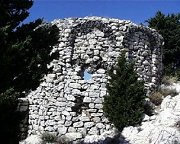 The Liburnians, an Illyrian people, are the earliest inhabitants of the island known to history. They did not build fortifications or towers, having mainly been cattlemen, hunters, farmers and fishermen.
The Liburnians, an Illyrian people, are the earliest inhabitants of the island known to history. They did not build fortifications or towers, having mainly been cattlemen, hunters, farmers and fishermen.
The conflict between the Liburnians and the Greek started as early as the 8th century B.C. In spite of strong resistance put up by former the Greeks kept penetrating deeper into the Adriatic. According to historical records, in 365 B.C. the liburnians were defeated for the second time in a fierce sea battle somewhere off the coast on the island of Krk and Rab. The Greek captain, Dionysus the Younger, took advantage if victory in order to build several fortifications on the north Adriatic islands, intended to prevent any Liburnian takeover of the area.
The ruins of St. Damjan, Kasteline at Kampor and Punte-zidine at Lopar are through to be remains of these military camps. For a whole century the Greeks ruled supreme in the Adriatic. However, after the alliance between the Ardeans, another Illyrian people whose state was in the area of lake Skadar, and the Liburnans, the predominance of the Greeks began to wane, first in the north and then in the south. Just as the Ardeans were about to capture the last Greek strongholds, the island of Vis, the Greek of Vis sought help from Rome and became Roman allies. |
|
|
| |
| Period of Romans Rule |
|
| |
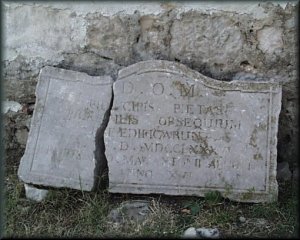 The alliance with the Greek on Vis gave the Romans a bridgehead on the Adriatic, and whetted their appetites for predominance in the area. After violent clashes the Romans forced Teuta, Ardean queen, to surrender. She had to relinquish part of her estates, and renounce the alliance with Liburnians and the Greeks on Hvar. Simultaneously, both the Liburnans and the Greeks had to recognize Roman sovereignty. The parts of the coast and the islands, which thus came under Roman rule, became important bridgeheads for later roman conquests. Aware of the peril, the hitherto discordant Illyrian tribes united to fight the Romans. At the same time, however, the Romans rebuilt the demolished Greek fortifications, and had new ones built, particularly on the islands. One of the Romans naval bases was probably built, as early as the 2nd century B.C., on the site of the present day town of Rab. The Illyrians fought Roman rule for no less than two centuries, but the Romans mercilessly crushed their rebellation The alliance with the Greek on Vis gave the Romans a bridgehead on the Adriatic, and whetted their appetites for predominance in the area. After violent clashes the Romans forced Teuta, Ardean queen, to surrender. She had to relinquish part of her estates, and renounce the alliance with Liburnians and the Greeks on Hvar. Simultaneously, both the Liburnans and the Greeks had to recognize Roman sovereignty. The parts of the coast and the islands, which thus came under Roman rule, became important bridgeheads for later roman conquests. Aware of the peril, the hitherto discordant Illyrian tribes united to fight the Romans. At the same time, however, the Romans rebuilt the demolished Greek fortifications, and had new ones built, particularly on the islands. One of the Romans naval bases was probably built, as early as the 2nd century B.C., on the site of the present day town of Rab. The Illyrians fought Roman rule for no less than two centuries, but the Romans mercilessly crushed their rebellation
During the reign of the roman emperor Octavian Augustus, the small Roman colony on the site of the present-day town of Rab rose to status of a Roman Municipium. Defensive walls and towers were built, and Rab became a Rome in miniature, with its own constitution, municipal administration, the municipal treasurer, priest and the senate. Numerous temples, squares, court halls, baths, theatres, a water supply system, etc. Were built in this period. Few of these structures have survived to the present day.
Thought the Western Roman Empire fell in 476, it was only in 493 that Rab, and all of Dalmatia, became part of the Ostrogothic Kingdom of Theodoric. During the thirty years of Theodoric's rule the kingdom prospered as it prospered during the reign of the first roman emperors. The fall of the Ostrogothic kingdom and the restoration of imperial power in Italy (544) brought Dalmatia, for the first time, under Byzantine rule, although for a short time. |
|
|
| |
| Migration of Slav People
|
|
| |
|
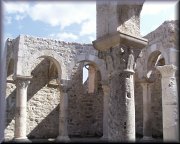 In the 6th and 7th centuries Slav people overran the area, which they still inhabit. Before the Slav onslaught the Romans sought refuge in the coastal towns and on the islands, but these were, too, conquered by the Slavs after the death of the emperor Maricis in 604. Rab suffered the same fate - the Slavs settled throughout the island, only partly sparing the town if Rab and its Roman population. The Slavs were livestock breeders' and farmers, and initially they cared little for the walled-in towns. In time, however, they began to move into the towns, too, assimilating the roman population. The towns, rivers, mountains and villages were given Slav names, and thus Arba became Rab. For more than century the Slavs in Dalmatia lived independently, in spite of the many attempts of the roman popes to establish their hierarchy. In the 6th and 7th centuries Slav people overran the area, which they still inhabit. Before the Slav onslaught the Romans sought refuge in the coastal towns and on the islands, but these were, too, conquered by the Slavs after the death of the emperor Maricis in 604. Rab suffered the same fate - the Slavs settled throughout the island, only partly sparing the town if Rab and its Roman population. The Slavs were livestock breeders' and farmers, and initially they cared little for the walled-in towns. In time, however, they began to move into the towns, too, assimilating the roman population. The towns, rivers, mountains and villages were given Slav names, and thus Arba became Rab. For more than century the Slavs in Dalmatia lived independently, in spite of the many attempts of the roman popes to establish their hierarchy.
Pope John IV (639-642) himself a Dalmatian, showed particular interest in Dalmatia. Where the Roman popes failed, however, the Byzantine emperors succeeded in the mid-8th century. They expanded their rule over the coast and the islands, reconstructed the ancient Roman fortifications, and established autonomous communes after the pattern of the ancient Roman municipal. Rab, too, had its municipial council, its magistrate's officers, treasurers and tax collectors. Church hierarchy was also established, with the bishop at its head.
As the ruler of the Western Roman Empire, Charlemagne laid claim Dalmatia, and war between the two empires ensued. The subsequent peace treaty of Aachen (803) assigned several coastal towns and the islands, including Rab, to the Byzantine Empire. This cut off the coastal towns and the islands from their hinterland until the end of the 9th century.
|
|
|
| |
| Period of Croatian Rulers |
|
| |
By the end of the 9th century Croatia had become an independent state under Prince Branimir (879-892). Rab paid a yearly tribute of 100 gold pieces to the Prince. By the time the Croats had already adopted the Chriatian faith, spread in these regions by the disciples of Cyril and Methoddius, in the Slav language and the Slav script) the Glagolitic). However, until Tomislav, the first Croatia king, came to power in 925, the coastal towns and the islands (Rab also) recognized Byzantine sovereignty. After 925, they, too, became a part of Croatia kingdom. At the time rab was autonomous commune with its own statutes; it enjoyed autonomy in electing its administration, concluding trade agreements etc.
A new power then appeared on the opposite coast of the Adriatic. Venice. In took Croatian rulers a lot effort to prevent Venetian expansion to the eastern Adriatic seaboard. In the early 11th century Venice occupied Rab and other Dalmatian islands on two occasions, but during the reign of the Croatian's most powerful king, Petar Kresimir IV (1058-1073), Dalmatia as whole became part of Croatian kingdom again, and Petar proclaimed himself king of Dalmatia nad Croatia. 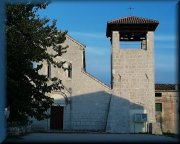
In 1059, Drago, bishop of Rab, invited the Benedictines t the island and granted then a large estate, with small churches of St. Peter and St. Cyprian in Supetarska Draga. The deed of donation was confirm by king Petar Kresimir Iv himself on May 16, 1070. In the same year the king granted extensive privileges to the diocese of Rab, including authority over part of the island of Pag and over some parishes in the Croatian Littoral. Under the Croatian rulers Rab prospered economically and culturally. Many worthy architectural details of the period have been preserved to date in the churches and monasteries.
|
|
|
| |
| Croato-Hungarien Kings
|
|
| |
|
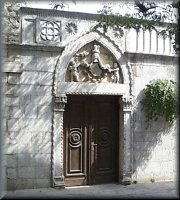 As the Croatian dynasty became extinct the country came under the rule of dynasty of Arpad and, later, of Anjou. The first king of the house Arpad was Kolomanm who confirmed some privileges the Dalmatian tows had previously enjoyed. He also confirmed, by the charter in 1111m the privileges granted to the diocese of Rab by Petar Kresimir IV, and donated a precious crucifix. The Croato-Hungarian king Bela IV, of the same house, sought refuge in Rab, in 1241, while feeing the Mongols. As the Croatian dynasty became extinct the country came under the rule of dynasty of Arpad and, later, of Anjou. The first king of the house Arpad was Kolomanm who confirmed some privileges the Dalmatian tows had previously enjoyed. He also confirmed, by the charter in 1111m the privileges granted to the diocese of Rab by Petar Kresimir IV, and donated a precious crucifix. The Croato-Hungarian king Bela IV, of the same house, sought refuge in Rab, in 1241, while feeing the Mongols.
The other Arpad kings were not particularly concerned with Dalmata and the islands and Venice cunningly took advantage of this in order to reinforce its influence in the area. Louis the Great of Anjou freed the Dalmatina towns on Venetian domination as late as 1358. He also confirmed the privileges granted to the diocese of Rab by Kresimir and Kolomon, with a special charter, in 1367.
In the early 15th century, after the death of Louis the Great, Venice, taking advantage of internal dynastic struggles, took over the Dalmatia towns and islands, and remained their master until its fall in 1797. |
|
|
| |
| Rab under Venetian Rule
|
|
| |
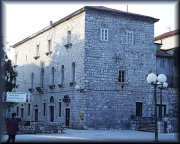 In the middle Ages, Rab was n important point in the trade between the West and the east had a powerful merchant navy, and the population prospered. The population of Rab reached its peak in the late 14th century; 10000, of which 5000 in the town itself. The many beautiful buildings of the period clearly bear witness to its prosperity.
In the middle Ages, Rab was n important point in the trade between the West and the east had a powerful merchant navy, and the population prospered. The population of Rab reached its peak in the late 14th century; 10000, of which 5000 in the town itself. The many beautiful buildings of the period clearly bear witness to its prosperity.
The discovery of the new route to India reduced the importance of the Mediterranean, and of the Adriatic, on Orient trade, Rab, like most Adriatic towns, gradually began to decline.
During its rule over the region Venice did, to be sure, build many beautiful buildings, contribute to economic grown and the development of the arts; however, it also imposed it laws and customs, which put an end to any autonomy. The citizens hardly administrated their towns any more, except for some internal matters.
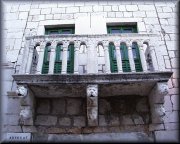 In Rab, too, Venetian rule put an end to autonomy hitherto enjoyed by the island, The Venetians also took cunning advantage of the friction between the patricians and the people, thus promoting the process to decline. In Rab, too, Venetian rule put an end to autonomy hitherto enjoyed by the island, The Venetians also took cunning advantage of the friction between the patricians and the people, thus promoting the process to decline.
In the period of this greatest prosperity Rab was struck by the plague epidemic which decimated the population on two occasions in 1449 and 1456. The southern part of the town, Kladanac suffered the most, and the hitherto liveliest district became almost deserted. Rab never fully recovered from the calamity, although its population increased again by the flow of refugees from the Turkish-ruled mainland. Rab was under Venetian rule until May 12, 1797, when Napoleon aboilished the Venetian Republic.
In the same year Napoleon ceded Dalmatia to Austria, but the peace treaty of Pressburg (1805) again assigned Dalmatia to France. The first French troops arrived in Rab in 1809. After Napoleon's defeat in 1813, Austria again took over Dalmatia. The Congress of Vienna granted Austria the rule over Dalmatia, which was to last until 1918.
|
|
|
| |
| Rab in Period 1918-1945 |
|
| |
|
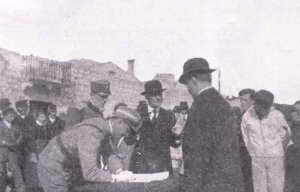 After the end of World War I base machinations of the great powers assigned Rab and some parts of Dalmatia to Italy. Finally, in 121 it was annexed to the Kingdom of Serbs, Croats and Slovenes. On April 23, 1921, the people of Rab, celebrating the great day of unity with their Croatian homeland, planted a Holm oak in the square named Freedom Square; today this is a beautiful tree and worthy symbol of freedom. After the end of World War I base machinations of the great powers assigned Rab and some parts of Dalmatia to Italy. Finally, in 121 it was annexed to the Kingdom of Serbs, Croats and Slovenes. On April 23, 1921, the people of Rab, celebrating the great day of unity with their Croatian homeland, planted a Holm oak in the square named Freedom Square; today this is a beautiful tree and worthy symbol of freedom.
In the period between two world wars there were no industrial activities; tourism did develop but employed relativity few people. People were mainly farmers, fishermen and livestock breeders.
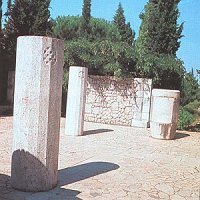 During Italian occupation (1941-1943) a considerable part of the fertile Kampor valley was the site of the infamous fascist concentration camp where, from 1942 to the capitulation of Italy in 1943, about 15000 internees felt all the brutality of fascism. More then 4500 never left the camp. During Italian occupation (1941-1943) a considerable part of the fertile Kampor valley was the site of the infamous fascist concentration camp where, from 1942 to the capitulation of Italy in 1943, about 15000 internees felt all the brutality of fascism. More then 4500 never left the camp.
Rab was free from the capitulation of Italy to March 19, 1944. on March 19, 1944, Germans and Ustase (local nazi forces) units occupied the island. The enemy infantry, navy and air forces controlled the island and the sea, but the people again showed their resourcefulness and kept helping the Liberation Movement until the end of the war. Von der Kapitulation Italiens bis zum 19 März 1944 war Rab freies Territorium. Am 19 März 1944 landeten in Rab zwei deutsche Truppen mit 700 Soldaten. Gleich nach den Deutschen kamen am 20. März auch die Ustascha Truppen auf Rab und richteten dort bis ende März ihre Verwaltung ein.
|
|
|
| |
| Rab after WW2 |
|
| |

After the end of the WW2 Rab repaired the tourism industry from, but in that time it was hardly a considerable tourism, since Europe had to recover from the war consequences. The inhabitants lived very hard with agriculture, fishing and cattle breeding; them built on free will basis; roads, schools and other vital infrastructure. Many people left Rab, in search for better life, they set up home in bigger cities of inland or also abroad, many of thet, later returned. With insensitive grown up of Travel industry and economic recovery of Western Europe, Rab had a change to use natural and culture-historical advantages into the service of the tourism and to raise so personal standard of living on island. Despite the heavy political and economic crisis in Croatia in February in the spring 1990 the first democratic multi-party elections of the post-war period were held, and the announced reforms promise also a progress in the area of the tourism.
Today the people of Rab have chosen their road of development and set their objectives. These involve first and most the preservation of the natural resources - the vegetation and the clear sea. Tourism will remain the basis activity-. Every effort will be made to improve even more the quality of tourist service, and extend the season to the whole year, thus providing for jobs and social security of all the islanders.
|
|
|

|

